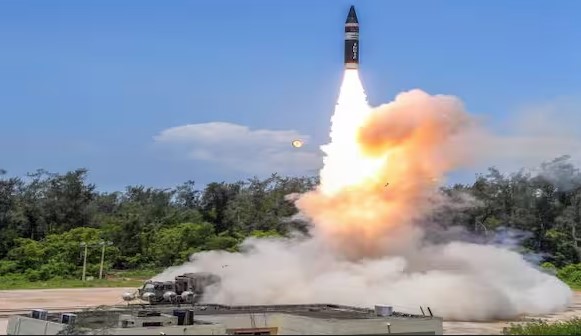India has achieved a significant milestone in its strategic defense program with the successful test of the next-generation Agni-Prime missile. This test was conducted from a specially designed rail-based mobile launcher, marking the first time India has launched a missile of this class from a rail platform. The successful trial demonstrates a major advancement in the country’s missile deployment and operational capabilities.
First-Ever Launch from Rail Mobile Platform
The test was carried out under a full operational scenario, which means it simulated a real-world deployment situation rather than being a limited trial or lab experiment. The missile was fired on Wednesday, and officials confirmed that it achieved all its mission objectives with high precision. The Ministry of Defense described the launch as a “textbook operation,” emphasizing the smooth execution and accuracy of the system.
The missile’s trajectory, or flight path, was closely monitored by a network of advanced ground-based tracking stations. These stations captured real-time data, confirming that all systems performed exactly as intended. The precise monitoring demonstrated that the Agni-Prime missile is fully ready for operational use, with reliable performance in realistic conditions.
China unveils YJ-12 Mach-6 missile drawing direct comparisons with India’s BrahMos
Agni-Prime: A New-Generation Missile
The Agni-Prime, also referred to as Agni-P, is an advanced intermediate-range ballistic missile. It is canisterised, meaning it is stored and launched from a protective container. This feature allows the missile to be deployed quickly while ensuring it remains safe during transport and storage. The canisterised design also protects the missile from environmental factors such as dust, moisture, and temperature fluctuations.
The missile has a range of up to 2,000 kilometers, allowing it to strike targets at significant distances with high accuracy. It incorporates modern technologies such as advanced guidance systems, improved navigation mechanisms, and lightweight composite materials. These features make the missile both highly efficient and powerful, capable of rapid deployment while maintaining precision.
The successful trial from a rail-based launcher adds a new dimension to India’s missile program. Previously, Agni-Prime had been tested and deployed using road-mobile launchers. By integrating a rail-based platform, India now has the flexibility to launch missiles from multiple types of mobile systems. This improves operational readiness and increases the strategic unpredictability of India’s defense forces.
The trial also validated that the missile is fully operational in real-world deployment conditions. Its smooth performance in this realistic scenario demonstrates the maturity and strength of India’s missile technology, highlighting the reliability of the systems developed by Indian defense agencies.
Rail-Based Mobile Launcher: A Unique Capability
What makes this test particularly significant is the use of the Rail-Based Mobile Launcher (RBML). This launcher has been specially designed to operate across India’s vast railway network without the need for prior arrangements or setup. Unlike older systems that required specific launch sites, the RBML can move along regular rail tracks, providing unmatched mobility and strategic flexibility.
The RBML is self-sufficient, equipped with its own independent launch systems, advanced communication networks, and strong protective measures. This allows it to operate autonomously, ensuring rapid response capability and enhanced survivability even in complex operational conditions.
The platform offers several key advantages. First, it allows a quick reaction time since the missile can be moved and launched swiftly from different locations. Second, its mobility reduces visibility, making it harder for potential adversaries to track or target it. Third, its robust design ensures the launcher can operate reliably even under demanding conditions, maintaining operational readiness at all times.
The combination of the Agni-Prime missile and the RBML platform significantly strengthens the survivability of India’s strategic missile assets. In simpler terms, it ensures that these crucial defense systems remain mobile, secure, and ready for deployment whenever required.
By successfully launching the missile from the RBML, India has joined a select group of nations capable of firing missiles from a canisterised rail-based platform. This represents a major leap in missile deployment strategies and a significant enhancement of India’s strategic deterrence capabilities.
